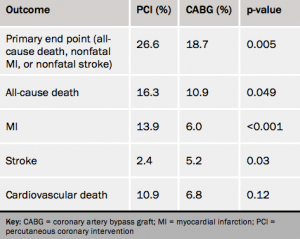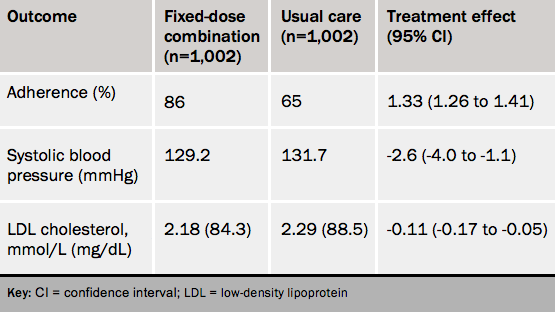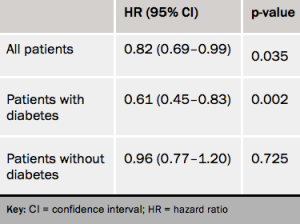Highlights of the American Heart Association 2012 meeting held on 3rd – 7th November 2012 in Los Angeles, USA, included a win for surgery in people with diabetes and multi-vessel disease, and intriguing results for colchicine and chelation therapy.
FREEDOM: CABG beats PCI in diabetes patients with multi-vessel disease
Coronary artery by-pass graft (CABG) surgery was associated with better outcomes than percutaneous coronary intervention (PCI) in patients with diabetes with multi-vessel coronary artery disease in the FREEDOM (Future Revascularization Evaluation in Patients With Diabetes Mellitus: Optimal Management of Multi-vessel Disease) trial.
Senior FREEDOM investigator, Dr Valentin Fuster (Mount Sinai School of Medicine, New York, USA), said the results (table 1) would change practice. He estimated that patients in this study represent about a quarter of patients undergoing PCI.
In the study, which was sponsored by the US National Heart, Lung, and Blood Institute, 1,900 patients with diabetes, the majority of whom had three-vessel disease, were randomised to treatment with CABG surgery or PCI with drug-eluting stents. Dual antiplatelet therapy was recommended for at least 12 months, and patients were followed for a median of 3.8 years.

Those undergoing bypass surgery had lower rates of death and myocardial infarction (MI). Although there were more strokes in the CABG group, this was not enough to negate the net significant benefits of fewer deaths and heart attacks, Dr Fuster said.
Previous studies in this group of patients also showed that bypass was favorable compared to PCI, but many of those studies did not use drug-eluting stents. “The cardiology community didn’t know if that held true when compared exclusively to newer, drug-covered stents,” said Dr Fuster, “so we are very excited to find the answer.”
The researchers observed no significant interaction based on SYNTAX score, with the absolute difference in the primary end point between PCI and surgery similar in patients with a low, intermediate, and high SYNTAX score. Given the wide variability of the patients enrolled in FREEDOM, as evidenced by the wide distribution of SYNTAX scores at baseline, the trial represents real-world practice and should be considered a strength of the study, according to the investigators.
In an accompanying editorial (New Engl J Med 2012; doi: 10.1056/NEJMe1212278) to the study (doi: 10.1056/NEJMoa1211585), Dr Mark Hlatky (Stanford University School of Medicine, California, USA) says the controversy surrounding the optimal revascularisation strategy in patients with diabetes “should finally be settled”. The results of the FREEDOM study “suggest that patients with diabetes ought to be informed about the potential survival benefit from CABG for the treatment of multi-vessel disease”.
Cost-effective
CABG was also said to be cost-effective for these patients according to a cost analysis of the FREEDOM trial, presented by Dr Elizabeth Magnuson (Saint Luke’s Mid America Heart Institute, Kansas City, USA). The cost of CABG surgery was calculated at US $34,467 while the cost of PCI was US $24,845, although the gap between the two narrowed from US $8,622 to US $3641 by year five.
Over the course of a lifetime, assuming a life expectancy of 12 years following the procedure, CABG was associated with 0.66 quality-adjusted life-years (QALYs) gained and approximately higher costs of US $5,400 per patient. This resulted in an incremental cost-effectiveness ratio of US $8,132 per QALY gained.
Dr Magnuson said that, even by the most conservative estimates, limiting the cost-effectiveness analysis to the five-year study period, the incremental cost-effectiveness ratio was approximately US $27,000 per QALY gained.
Small ICD change dramatically cuts inappropriate shocks
A simple change in implantable cardioverter defibrillator (ICD) programming cut the risk of inappropriate shocks by almost 80% in the MADIT-RIT (Multicenter Automatic Defibrillator Implantation Trial-Reduce Inappropriate Therapy) study. The alternate programming was also associated with a significant reduction in mortality in the patients with primary-prevention ICDs.
The study was presented at the meeting by Dr Arthur Moss (University of Rochester, New York, USA), and simultaneously published in the New England Journal of Medicine (doi: 10.1056/NEJMoa1211107). It randomised 1,500 patients to one of three ICD-programming groups: a “high-rate-therapy” group with a 2.5-second delay before starting anti-tachycardia pacing at a heart rate of >200 beats per minute; a “delayed-therapy” group with longer delays at different pre-specified heart-rate thresholds; and conventional programming with delays of 2.5 seconds for heart rates of 170 to 199 beats per minute and of 1 second for rates >200 beats per minute.
The high rate therapy group did best (table 2). With conventional programming, anti-tachycardia pacing starts at about 170 beats per minute, Dr Moss explained, but this often isn’t needed, because many rhythms in the 170–200 range tend to stop spontaneously, and anti-tachycardia pacing can induce ventricular fibrillation. The higher rate therapy did not increase the risk of fainting, as some had expected.

Discussant of the study, Dr Douglas Zipes (Krannert Institute of Cardiology, Indianapolis, USA) described it as “a game changer”. He added: “If after reading this paper, physicians wish to reprogram devices according to [the recommendation of MADIT-RIT], then that’s certainly quite reasonable”.
In an editorial accompanying the publication (doi: 10.1056/NEJMe1212457), Dr Bruce L Wilkoff (Cleveland Clinic, Ohio, USA) writes that MADIT-RIT shows that “the value of ICD therapy is greatly influenced and in many ways determined by the programming choices made by the physician. A patient’s unnecessary exposure to painful shocks and his or her very survival may depend on these choices. Choose wisely!”
Flaxseed reduces blood pressure
Patients with peripheral arterial disease (PAD) who added flax seeds to their diets experienced drops in blood pressure of around 10 mmHg systolic and 7 mmHg diastolic after six months, according to a new study.
Presenting the results, Dr Delfin Rodriguez (University Hospital Holguin, Cuba) said: “This is the largest reduction of blood pressure ever shown by any dietary intervention”. Such reductions would be expected to result in around a 50% fall in the incidence of stroke and a 30% reduction in myocardial infarction, he added.
Dr Rodriguez noted that around 75% of PAD patients have hypertension. Subgroup analyses of only those PAD patients with hypertension showed an even greater reduction in blood pressure.
“Flaxseed represents a particularly attractive strategy for controlling hypertension in economically disadvantaged communities and countries, and its blood pressure lowering effects compare favourably with those of antihypertensive drugs and lifestyle modifications, such as a low-salt diet and weight loss,” he said.
Dr Rodriguez chose to study flaxseed because it has been shown in animal studies to have anti-atherogenic, anti-inflammatory, and anti-arrhythmic effects and may reduce circulating cholesterol and trans-fatty acid levels.
The researchers randomised 110 patients with PAD to milled flaxseed (30 g/day) in the form of bagels, muffins, and buns or placebo products, made from wheat with a similar flavor, for one year.
They are now trying to determine which particular constituents of flaxseed may be responsible for the antihypertensive effects. The flaxseed group exhibited a two-fold increase in plasma alpha-linolenic acid and a 10-fold increase in enterolactone levels. “Flaxseed has different components, including alpha-linolenic acid, enterolignans, and fiber, and all have been shown to decrease blood pressure. We think we are seeing a synergistic effect of different compounds,” Dr Rodriguez commented.
UMPIRE shows benefit of polypill
A fixed-dose combination tablet including aspirin, a statin, and two antihypertensives improved compliance and led to significant reductions in low-density lipoprotein (LDL)-cholesterol and blood pressure when compared with usual care, in the UMPIRE (Use of a Multidrug Pill In Reducing Cardiovascular Events) study.
Overall, there was a 33% increase in compliance over a 15-month period with the polypill, which lead investigator Dr Simon Thom (Imperial College, London) suggested should translate into a reduction of cardiovascular events. Patients who stopped taking the combination pill quickly reverted back to usual care and its accompanying low rate of compliance.
The UMPIRE study included 2,004 patients randomised to fixed-dose combination therapy with aspirin 75 mg, simvastatin 40 mg, lisinopril 10 mg, and atenolol 50 mg or to usual care. A second combination substituted hydrochlorothiazide 12.5 mg for atenolol. Doctors were free to add additional medications, stop the fixed-dose combination therapy and begin treatment with usual medications, or switch from one version of the combination therapy to the other combination at any time.
Patients included either already had cardiovascular disease (88%) or were at risk, with 28% having diabetes. About 60% of patients in the polypill arm were already taking aspirin, a statin, and two antihypertensive medications; 88% of patients were taking a statin and 91% were taking aspirin.

After 15 months (see table 3), 86% of patients in the polypill group were taking the medication compared with 65% in the usual-care arm, a statistically significant difference. This translated into an improvement in low-density lipoprotein cholesterol levels and blood pressure.
Discussant of the study, Dr Andrew Tonkin (Monash University, Melbourne, Australia), said: “Both physicians and government should pay attention to these results”. He suggested that the study may have underestimated the true benefit of the polypill approach, since there was very high baseline use of medications at study onset, and the usual-care group showed higher levels of medication adherence than normal.
LoDoCo: colchicine effective for secondary prevention
More data suggesting that colchicine, a drug long used to treat gout and familial Mediterranean fever, is useful for the secondary prevention of cardiac events in patients with stable coronary disease, has come from the LoDoCo (Low-Dose Colchicine) study.
The study randomised 532 patients with stable coronary artery disease (CAD) to low-dose colchicine or placebo for a minimum of two years. During a median follow-up of three years, the primary outcome (acute coronary syndrome [ACS], out-of-hospital cardiac arrest, or non-cardioembolic ischaemic stroke) was seen in 16% of placebo patients versus 5.3% of those on colchicine, a significant 67% relative risk reduction. The number needed to treat to prevent one primary clinical outcome was 11.
Presenting the data, Dr Stefan Nidorf (Heart Research Institute of Western Australia, Perth) said: “Colchicine is well studied, readily available, simple to use, inexpensive, and has shown no major irreversible, long-term toxicity over decades of use. Therefore its role in the routine management of patients with proven coronary disease clearly requires further investigation”.
He explained that colchicine has been shown to be effective in preventing neutrophil-mediated inflammation, as documented by its efficacy in the treatment of gout. As neutrophils are activated in culprit lesions of patients with ACS, it was proposed that inhibiting neutrophil function might reduce the risk of plaque instability and subsequently clinical instability in patients with cardiovascular disease.
Discussant of the study, Dr Shinya Goto (Tokai University School of Medicine, Kanagawa, Japan) said that larger trials of colchicine should now be conducted. He also pointed out that gastrointestinal side effects may limit the drug’s use to some extent, noting that 11% of patients dropped out of the LoDoCo trial mainly because of gastrointestinal issues.
TACT: chelation therapy shows benefit post MI
The biggest surprise of the meeting was the finding that chelation therapy was associated with improved clinical outcomes in patients after an acute myocardial infarction (MI) in the randomised controlled TACT (Trial to Assess ChelationTherapy) trial.
The trial, sponsored by the US National Institutes of Health, randomised 1,708 patients to infusions of a chelation solution which included disodium ethylenediaminetetraacetic acid (EDTA), ascorbic acid, magnesium chloride, potassium chloride, sodium bicarbonate, B vitamins, procainamide, standard heparin, and water, or placebo (saline and glucose). About 65% of the patients completed all 40 prescribed infusions; 76% completed at least 30.

Results (table 4) showed that the primary end point – a composite of all-cause mortality, MI, stroke, coronary revascularisation, and hospitalisation for angina – was reduced by 18% in the chelation group. The effect seemed to be stronger in diabetics.
Presenting the data, Dr Gervasio Lamas (Mount Sinai Medical Center, Miami, USA) said that chelation therapy “showed some evidence of a potentially important treatment signal in post-MI patients already on evidence-based therapy,” and “appears to be safe” as given and monitored in the trial. But he added that clinical use of chelation therapy could not be recommended at this time based on these unexpected results. However, he did suggest that such treatment should be pursued with additional research.
In a statement, the American Heart Association said that TACT raises many questions, including which elements of the complex infusion mixture might provide benefit, and why there was such a discordance between the effect in people with and without diabetes. “As intriguing as the results are, they’re unexpected and should not be interpreted as an indication to adopt chelation therapy into clinical practice,” the statement added.
